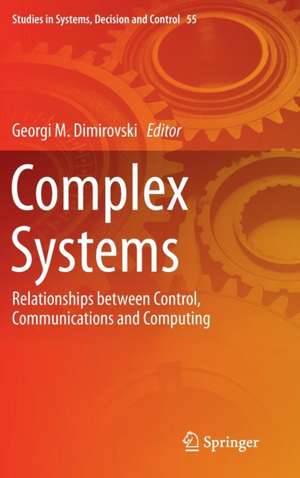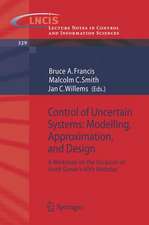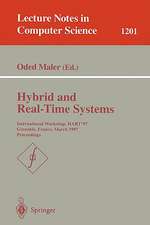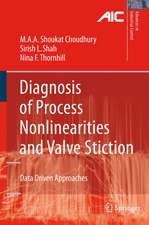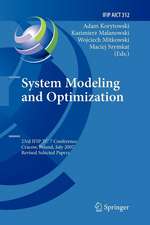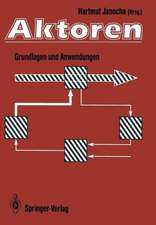Complex Systems: Relationships between Control, Communications and Computing: Studies in Systems, Decision and Control, cartea 55
Editat de Georgi M. Dimirovskien Limba Engleză Hardback – 27 mai 2016
Reporting on work of the Control of Complex Systems (COSY) research program, Complex Systems follows from and expands upon an earlier collection: Control of Complex Systems by introducing novel theoretical techniques for hard-to-control networks and systems.
The major common feature of all the superficially diverse contributions encompassed by this book is that of spotting and exploiting possible areas of mutual reinforcement between control, computing and communications. These help readers to achieve not only robust stable plant system operation but also properties such as collective adaptivity, integrity and survivability at the same time retaining desired performance quality.
Applications in the individual chapters are drawn from:
• the general implementation of model-based diagnosis and systems engineering in medical technology, in communication, and in power and airport networks;
• the creation of biologically inspired control brains and safety-critical human–machine systems,
• process-industrial uses;
• biped robots;
• large space structures and unmanned aerial vehicles; and
• precision servomechanisms and other advanced technologies.
Complex Systems provides researchers from engineering, applied mathematics and computer science backgrounds with innovative theoretical and practical insights into the state-of-the-art of complex networks and systems research. It employs physical implementations and extensive computer simulations. Graduate students specializing in complex-systems
| Toate formatele și edițiile | Preț | Express |
|---|---|---|
| Paperback (1) | 964.86 lei 43-57 zile | |
| Springer International Publishing – 30 mai 2018 | 964.86 lei 43-57 zile | |
| Hardback (1) | 971.32 lei 43-57 zile | |
| Springer International Publishing – 27 mai 2016 | 971.32 lei 43-57 zile |
Din seria Studies in Systems, Decision and Control
- 18%
 Preț: 937.89 lei
Preț: 937.89 lei - 18%
 Preț: 729.53 lei
Preț: 729.53 lei - 20%
 Preț: 627.40 lei
Preț: 627.40 lei - 15%
 Preț: 644.18 lei
Preț: 644.18 lei - 18%
 Preț: 900.80 lei
Preț: 900.80 lei - 18%
 Preț: 947.35 lei
Preț: 947.35 lei - 20%
 Preț: 1467.93 lei
Preț: 1467.93 lei - 18%
 Preț: 1012.84 lei
Preț: 1012.84 lei - 15%
 Preț: 653.33 lei
Preț: 653.33 lei - 20%
 Preț: 835.23 lei
Preț: 835.23 lei - 18%
 Preț: 1112.30 lei
Preț: 1112.30 lei - 20%
 Preț: 934.24 lei
Preț: 934.24 lei - 24%
 Preț: 726.59 lei
Preț: 726.59 lei - 18%
 Preț: 1004.81 lei
Preț: 1004.81 lei - 20%
 Preț: 924.72 lei
Preț: 924.72 lei - 18%
 Preț: 1010.48 lei
Preț: 1010.48 lei - 20%
 Preț: 932.21 lei
Preț: 932.21 lei - 18%
 Preț: 1007.35 lei
Preț: 1007.35 lei - 18%
 Preț: 752.43 lei
Preț: 752.43 lei - 18%
 Preț: 1000.24 lei
Preț: 1000.24 lei - 18%
 Preț: 999.45 lei
Preț: 999.45 lei - 18%
 Preț: 1016.81 lei
Preț: 1016.81 lei - 18%
 Preț: 949.73 lei
Preț: 949.73 lei - 18%
 Preț: 1119.38 lei
Preț: 1119.38 lei - 18%
 Preț: 1412.20 lei
Preț: 1412.20 lei - 20%
 Preț: 1163.21 lei
Preț: 1163.21 lei - 18%
 Preț: 1116.26 lei
Preț: 1116.26 lei - 18%
 Preț: 783.20 lei
Preț: 783.20 lei - 18%
 Preț: 952.09 lei
Preț: 952.09 lei - 20%
 Preț: 1472.54 lei
Preț: 1472.54 lei - 18%
 Preț: 1392.46 lei
Preț: 1392.46 lei - 20%
 Preț: 1180.52 lei
Preț: 1180.52 lei - 18%
 Preț: 1567.67 lei
Preț: 1567.67 lei - 20%
 Preț: 984.18 lei
Preț: 984.18 lei - 20%
 Preț: 369.86 lei
Preț: 369.86 lei - 20%
 Preț: 1281.17 lei
Preț: 1281.17 lei - 18%
 Preț: 1582.67 lei
Preț: 1582.67 lei - 18%
 Preț: 1112.30 lei
Preț: 1112.30 lei - 20%
 Preț: 1055.94 lei
Preț: 1055.94 lei - 18%
 Preț: 1405.90 lei
Preț: 1405.90 lei - 18%
 Preț: 961.55 lei
Preț: 961.55 lei - 20%
 Preț: 1053.48 lei
Preț: 1053.48 lei - 20%
 Preț: 1049.37 lei
Preț: 1049.37 lei - 18%
 Preț: 1005.74 lei
Preț: 1005.74 lei - 18%
 Preț: 1225.94 lei
Preț: 1225.94 lei - 18%
 Preț: 1232.26 lei
Preț: 1232.26 lei - 18%
 Preț: 957.94 lei
Preț: 957.94 lei - 18%
 Preț: 890.54 lei
Preț: 890.54 lei
Preț: 971.32 lei
Preț vechi: 1184.55 lei
-18% Nou
Puncte Express: 1457
Preț estimativ în valută:
185.88€ • 192.89$ • 155.37£
185.88€ • 192.89$ • 155.37£
Carte tipărită la comandă
Livrare economică 17-31 martie
Preluare comenzi: 021 569.72.76
Specificații
ISBN-13: 9783319288581
ISBN-10: 331928858X
Pagini: 624
Ilustrații: LXXVI, 652 p. 318 illus., 118 illus. in color.
Dimensiuni: 155 x 235 x 40 mm
Greutate: 1.19 kg
Ediția:1st ed. 2016
Editura: Springer International Publishing
Colecția Springer
Seria Studies in Systems, Decision and Control
Locul publicării:Cham, Switzerland
ISBN-10: 331928858X
Pagini: 624
Ilustrații: LXXVI, 652 p. 318 illus., 118 illus. in color.
Dimensiuni: 155 x 235 x 40 mm
Greutate: 1.19 kg
Ediția:1st ed. 2016
Editura: Springer International Publishing
Colecția Springer
Seria Studies in Systems, Decision and Control
Locul publicării:Cham, Switzerland
Public țintă
ResearchCuprins
Introduction.- Part I Control and Supervision for Complex Networks and Systems.- Part II Machine Intelligence and Learning in Complex Control Systems.- Part III Control and Supervision of Complex Mechanical Structures and Robots.- Part IV Control and Supervision in Multi-Agent and Industrial Systems.- Part V Attenuation of Uncertain Disturbances through Fast Control Inputs Attenuation.- Concluding Remarks: A Look Forward to the Future.
Notă biografică
Georgi Marko Dimirovski is a Research Professor (life-time) of Automation & Systems Engineering at the Faculty of Electrical-Electronics Engineering and Information Technologies of SS Cyril and Methodius University of Skopje, R. Macedonia, and a Professor of Computer Science and Information Technologies at the Faculty of Engineering of Dogus University of Istanbul as well as an Invited Professor of Computer and Control Sciences at the Graduate Institutes of Istanbul Technical University (Aerospace Engineering) and of Dokuz Eylul University of Izmir (Mechatronics Engineering), R. Turkey, and a ‘Pro Universitas’ Professor at Doctoral School of Obuda University in Budapest, Hungary. He is a Foreign Member of Serbian Academy of Engineering Sciences in Belgrade. He received his Dipl.-Ing. degree in 1966 from SS Cyril and Methodius University of Skopje, R. Macedonia, M.Sc. degree in 1974 from University of Belgrade, R. Serbia, and Ph.D. degree in 1977 from University of Bradford, England, UK. He got his postdoctoral position in 1979 and subsequently was a Visiting Research Professor at the University of Bradford in 1984, 1986 and 1988 as well as at the University of Wolverhampton in 1990 and 1991. He was a Senior Research Fellow and Visiting Professor at Free University in Brussels, Belgium, in 1994 and also at Johannes Kepler University in Linz, Austria, in 2000. Georgi Dimirovski, along with Dr Qing-Kui Li and Dr Jun Zhao, is the recipient of the 2009 Premium of IET Control Theory & Applications for the best IET-CTA article in the previous year 2008. In 2011 he received the Outstanding Service Award of the International Federation of Automatic Control (IFAC). His research interests include nonlinear systems and control, complex dynamical networks, switched systems, and applied computational intelligence into decision and control problems. He has supervised or advised more than 30 doctoral students and 2 postdoctoral fellows. Dr Dimirovski has authored or co-authored 100 plus journal articles and 400 plus conference papers at international conferences worldwide, which yielded more than 900 citations in Scopus. At present, he serves the Asian J. of Control (Taipei, Taiwan; J. Wiley), International J. of Automation & Computing (Beijing, China; Springer), and CEAC journal (Bucharest, Romania) as an associate editor and member of the editorial board, while in the past he served IEEE SMC Transactions (The IEEE, Piscataway, USA), Proceedings IMechE Systems & Control Eng. (The Instution of Mechanical Engineers, London, UK), Facta Universitatis EE (Nis, R. Serbia), and IU Journal EEE (Istanbul, Turkey). in the same capacity.
Georgi Dimirovski was the acting program chair and editor of the 2003 IEEE Conference on Control Applications and of the 2010 IEEE Conference on Systems, Man and Cybernetics. He was the acting general chair or technical program chair of number of IFAC workshops and conferences as well as others during the last three decades. He served the IFAC in capacities of chair or co-chair of a technical committee as well as a chair of a coordinating commttee, with several technical committees, and was a member of IFAC Technical Board during 2005-2011. He has delivered plenary/keynote talks or invited lectures at a number of international conferences, among others, those sponsored by IFAC and the IEEE.
Georgi Dimirovski was the acting program chair and editor of the 2003 IEEE Conference on Control Applications and of the 2010 IEEE Conference on Systems, Man and Cybernetics. He was the acting general chair or technical program chair of number of IFAC workshops and conferences as well as others during the last three decades. He served the IFAC in capacities of chair or co-chair of a technical committee as well as a chair of a coordinating commttee, with several technical committees, and was a member of IFAC Technical Board during 2005-2011. He has delivered plenary/keynote talks or invited lectures at a number of international conferences, among others, those sponsored by IFAC and the IEEE.
Textul de pe ultima copertă
Thisbook gives a wide-ranging description of the many facets of complex dynamicnetworks and systems within an infrastructure provided by integrated controland supervision: envisioning, design, experimental exploration, andimplementation. The theoretical contributions and the case studies presentedcan reach control goals beyond those of stabilization and output regulation oreven of adaptive control.
Reportingon work of the Control of Complex Systems (COSY) research program, Complex Systems follows from and expandsupon an earlier collection: Control of Complex Systems by introducing noveltheoretical techniques for hard-to-control networks and systems.
Themajor common feature of all the superficially diverse contributions encompassedby this book is that of spotting and exploiting possible areas of mutualreinforcement between control, computing and communications. These help readersto achieve not only robust stable plant system operation but also propertiessuch as collective adaptivity, integrity and survivability at the same timeretaining desired performance quality.
Applicationsin the individual chapters are drawn from:
· the general implementation of model-based diagnosis and systemsengineering in medical technology, in communication, and in power andairport networks;
· the creation of biologically inspired control brains and safety-criticalhuman–machine systems;
· process-industrial uses;
· biped robots; · large space structures and unmanned aerial vehicles; and
· precision servomechanisms and other advanced technologies.
Complex Systems providesresearchers from engineering, applied mathematics and computer sciencebackgrounds with innovative theoretical and practical insights into thestate-of-the-art of complex networks and systems research. It employs physicalimplementations and extensive computer simulations. Graduate studentsspecializing in complex-systems research will also learn much from this collection.
Reportingon work of the Control of Complex Systems (COSY) research program, Complex Systems follows from and expandsupon an earlier collection: Control of Complex Systems by introducing noveltheoretical techniques for hard-to-control networks and systems.
Themajor common feature of all the superficially diverse contributions encompassedby this book is that of spotting and exploiting possible areas of mutualreinforcement between control, computing and communications. These help readersto achieve not only robust stable plant system operation but also propertiessuch as collective adaptivity, integrity and survivability at the same timeretaining desired performance quality.
Applicationsin the individual chapters are drawn from:
· the general implementation of model-based diagnosis and systemsengineering in medical technology, in communication, and in power andairport networks;
· the creation of biologically inspired control brains and safety-criticalhuman–machine systems;
· process-industrial uses;
· biped robots; · large space structures and unmanned aerial vehicles; and
· precision servomechanisms and other advanced technologies.
Complex Systems providesresearchers from engineering, applied mathematics and computer sciencebackgrounds with innovative theoretical and practical insights into thestate-of-the-art of complex networks and systems research. It employs physicalimplementations and extensive computer simulations. Graduate studentsspecializing in complex-systems research will also learn much from this collection.
Caracteristici
Shows the reader how to take advantage of relationships between control, communications and applied computing to produce solutions to a wide range of complex system problems Interrelation of case studies gives the reader insights into similar problems from various points of view Text makes extensive use of rigorous mathematical proof, computer simulation and experiment to demonstrate validity of its results Includes supplementary material: sn.pub/extras
